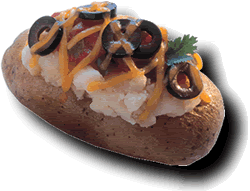 The Dark Side of the Potato
The Dark Side of the PotatoSince I live in the great "potato state" of Idaho, I think for this week's science of yum I'd like to head in the tuber direction. Henry Spalding first planted potatoes in Idaho in 1837 and we've been known for them ever since (although I've more commonly found Washington potatoes in local markets, due to the trucking lobbies that keep foods hopping borders). Now, try not to confuse us with Iowa, the land o' corn. Although corn goes rather well with potatoes, Idaho is not a Midwestern state. Rather, it's just one state inland from the west coast, cozied on up to Washington and Oregon to the West and Montana and Wyoming to the East.
Most of the state looks like this:

Although where I come from it looks more like this:

For as bland and boring as potatoes seem, it's only a guise; they are actually natural born killers. As a member of the nightshade family, they certainly have a shady history. The Irish potato famine of the 1840s caused many deaths, partially due to the scarcity of the major food staple after an outbreak of potato blight, but also due to the toxicity of the remaining potatoes. With little other option, people were opting to eat potatoes which had begun to produce the toxins which give nightshades their reputation: solanine and chaconine. Solanine and chaconine are glycoalkaloids, toxic compounds that cause dizziness, diarrhea, and, if consumed in high enough doses, death in humans. The small portion found in "good" potatoes has little to no effect. It's easy to tell, too, when a potato has turned into a bad tuber. They begin to green under the skin and some sprouting may be seen. If that isn't enough of a turn off, the bitter flavor is a good clue that it's time to toss the potato.
How to keep potatoes from going bad:
- store in dry, dark place
- avoid bruising or cutting
- don't let them wait too long before you eat them
- bake at high temperatures to partially destroy the toxic compounds
Oddly enough, glycoalkaloids are currently being researched for their anticarcinogenic qualities. Glycoalkaloids, when obtained through processing of common potatoes, seem to act to reduce cancerous cell growth. Now, don't go ahead and start mixing a little in with your meals (can you say Qin Shihuangdi?), as studies are still underway for finding safe ways to utilize the compound. They already exist in some skin creams shown to reduce the presence of skin caner.
Sources:
Cham and Meares. Cancer Letters. "Glycoalkaloids from Solanum sodomaeum are effective in the treatment of skin cancers in man." Aug 1987
Friedman, Lee, and Kim. Journal of Agricultural Food Chemistry. "Anticarcinogenic effects of glycoalkaloids from potatoes against human cervical, liver, lymphoma, and stomach cancer cells." Oct 2005
http://www.ansci.cornell.edu/plants/toxicagents/steroid.html
Images:
http://www.idahoptv.org/productions/idahoportrait/adventures/huntfish.html


0 Comments:
Post a Comment
<< Home